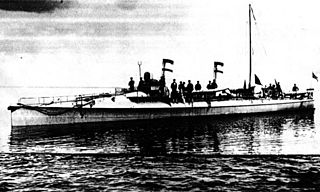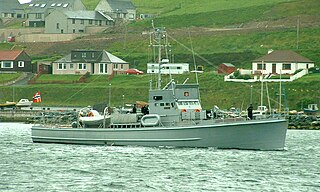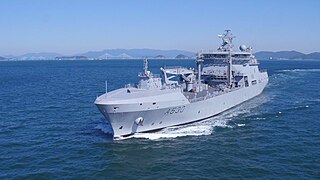
The Royal Norwegian Navy is the branch of the Norwegian Armed Forces responsible for naval operations of Norway. As of 2008, the Royal Norwegian Navy consists of approximately 3,700 personnel and 70 vessels, including 4 heavy frigates, 6 submarines, 14 patrol boats, 4 minesweepers, 4 minehunters, 1 mine detection vessel, 4 support vessels and 2 training vessels. It also includes the Coast Guard.

The Altmark incident was a naval incident of World War II between British destroyers and the German tanker Altmark, which happened on 16–17 February 1940. It took place in what were, at that time, neutral Norwegian waters. On board the Altmark were some 300 allied prisoners, whose ships had been sunk by the pocket battleship Graf Spee in the Southern Atlantic Ocean. British naval forces cornered the tanker and later the destroyer Cossack attacked the German ship near the Jøssingfjord and freed all the prisoners, killing eight German seamen with firearms and wounding ten others, five of them seriously. A British and a Norwegian sailor were also seriously wounded in the action. Germany claimed that the attack was a grave violation of international law and of Norwegian neutrality.

The Oslo-class frigate is a Royal Norwegian Navy frigate design, based on the US Navy Dealey-class destroyer escorts. The forward hull was customized to suit Norwegian sea conditions better and several sub-systems were European built.

The Ula class is a Norwegian submarine type which was assembled in Germany in the late 1980s and early 1990s. The class, consisting of six vessels, is currently the only submarine type in service with the Royal Norwegian Navy.

HNoMS Helge Ingstad was a Fridtjof Nansen-class frigate of the Royal Norwegian Navy. The vessel was ordered on 23 June 2000 and constructed by Navantia in Spain. The ship was launched on 23 November 2007 and commissioned on 29 November 2009. Named for Helge Ingstad, a Norwegian explorer, the Fridjtof Nansen class are capable of anti-air, anti-submarine and surface warfare. On 8 November 2018, HNoMS Helge Ingstad collided with the tanker Sola TS in Norwegian waters just outside Sture Terminal. Helge Ingstad was severely damaged in the collision and beached. On 13 November 2018, the ship sank where she had run aground and became a constructive total loss.

HNoMS Vidar (N52) was a Royal Norwegian Navy minelayer and command vessel. Vidar was built by Mjellem & Karlsen in Bergen in 1977, and named after Odin's son Vidar from Norse mythology. The vessel was the command ship for NATO's "Mine Counter Measures Force North" (MCMFORNORTH) in 2004 and 2005. In 2006 she was sold to Lithuania and given the name Jotvingis. The Lithuanian Navy uses her as a command and support ship.
HNoMS Valkyrien, HNoMS Valkyrjen has been the name of several ships in the Royal Norwegian Navy. Most of them have been in some way connected to the Royal Norwegian Navy's torpedo boats. The name honours the valkyries of Norse mythology. It has also been said that the ships have been given this name in honour of all women. Some of the ships:

HNoMS Valkyrjen was a torpedo boat destroyer of the Royal Norwegian Navy, built at F. Schichau shipyard in Elbing, Germany. The funds for the ship had been raised by the women of Norway and the ship was named Valkyrien in their honour. She was also nicknamed Damernes krigsskib. The ship had its first sea trial on 11 May 1896 and was swiftly approved. She was completed in Horten, Norway, and delivered to the minister of defence in Christiania (Oslo), on 17 May 1896. The ship was opened to the public for two days before sailing back to Horten.
HMS P41 was a Royal Navy U-class submarine built by Vickers-Armstrong. She was transferred to the exiled Royal Norwegian Navy before completion and renamed HNoMS Uredd. She and one of the B-class in 1940 have so far been the only Norwegian submarine to have been sunk.
HNoMS Tyr was a Gor-class Rendel gunboat built for the Royal Norwegian Navy at Karljohansverns Verft Naval Yard in Horten. She was laid down in 1884 and launched in 1887 with build number 67. Tyr was one of a class of two gunboats - the other ship in her class being HNoMS Gor. Gor and Tyr can be seen as improved Vale-class gunboats, of 290 tons instead of the 250 tons standard for that class.

HNoMS Æger was a Sleipner-class destroyer launched at Karljohansvern naval shipyard in Horten in 1936. The Sleipner class was part of a Norwegian rearmament scheme started as war became ever more likely in the 1930s. When the Germans invaded Norway on 9 April 1940, Æger intercepted and sank the clandestine German supply ship Roda. She was shortly afterwards attacked and sunk by German bombers, claiming two of the attacking aircraft with her anti-aircraft armament before being taken out of action by a heavy bomb.

HNoMS Horten (A530) was a Norwegian support vessel built at Karljohansvern in Horten, the city from which the ship was named, in 1977. She was in service with the Royal Norwegian Navy until her retirement in 2008 and filled a number of roles while in service.

HNoMS Sæl was the penultimate vessel of the ten 1. class torpedo boats of the Royal Norwegian Navy. She was built at the Royal Norwegian Navy Shipyard in Horten in 1901, with yard number 85. She was to see close to 40 years service with the Royal Norwegian Navy, taking part in the preparations for war in connection with the dissolution the union with Sweden in 1905, enforcing Norwegian neutrality during the First World War and opposing the German invasion of Norway in 1940. She was lost in battle with Kriegsmarine vessels at Ånuglo in the Hardangerfjord on 18 April 1940.

HNoMS Honningsvåg was a naval trawler that served throughout the Second World War as a patrol boat in the Royal Norwegian Navy. She was launched at the North Sea harbour of Wesermünde in Hanover, Germany in February 1940 as the fishing trawler Malangen and was captured by Norwegian militiamen at the North Norwegian port of Honningsvåg during her maiden fishing journey to the Barents Sea. Having taken part in the defence of Norway in 1940 she spent the rest of the war years patrolling the ocean off Iceland. She was decommissioned in 1946, sold to a civilian fishing company in 1947 and scrapped in 1973.

SS Irma was a 1,322-ton steamship built by the British shipyard Sir Raylton Dixon & Co. Ltd. in Middlesbrough in the north-east of England. She was delivered to the Norwegian passenger ship company Det Bergenske Dampskibsselskab of Bergen in 1905. Irma sailed for the company until she was attacked and sunk by two MTBs belonging to the Royal Norwegian Navy on 13 February 1944.

The Tide-class tanker is a class of four fast fleet tankers that entered service with the British Royal Fleet Auxiliary from 2017. The 37,000 t ships provide fuel, food, fresh water, ammunition and other supplies to Royal Navy vessels around the world. Norway ordered a similar 26,000 t version with a 48-bed hospital and greater solid stores capacity, but reduced liquid capacity; it was delivered in November 2018 as HNoMS Maud two years after originally planned. The two classes are very similar, but are not directly comparable due to large variance in capabilities delivered.

The HNoMS Vigra was a Royal Norwegian Navy submarine chaser that saw action during World War II. She was named after the Norwegian island of Vigra.

The HNoMS Hessa was a Royal Norwegian Navy submarine chaser that saw action during World War II. She was named after the Norwegian island of Hessa.

HNoMS Maud is a replenishment oiler constructed at Daewoo Shipbuilding & Marine Engineering in South Korea. She was built on behalf of the Norwegian Defense Materials Agency Forsvarsmateriell, for service in the Royal Norwegian Navy.

HNoMS B-5 was a Norwegian B-class submarine who was captured by an E-boat of the German Kriegsmarine during Operation Weserübung on 9 April 1940 at Kristiansand, Norway. After which she was renamed UC-1 and used as a school boat for the Kriegsmarine before she was deemed unsuited for reserve training and was broken up in 1942.

















